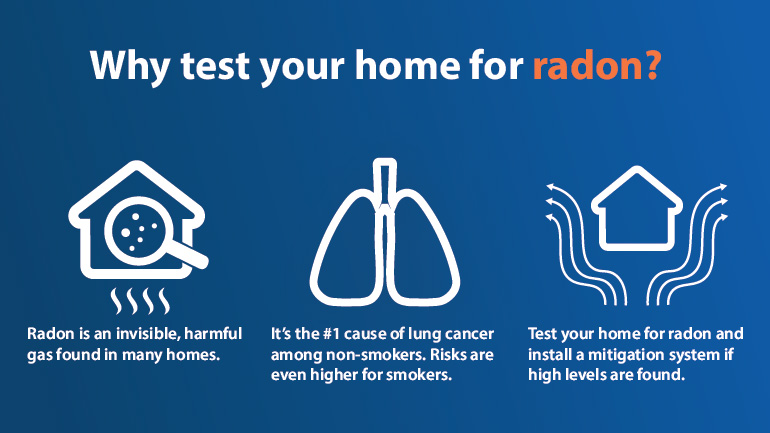-
Radon
Radon is a gas that you can’t see, smell or taste. It comes from the breakdown of uranium present in some rocks and soil. Outside, radon mixes with air to low levels. Radon can also enter homes and buildings through cracks in the foundation and openings in walls that are in contact with the soil. Levels can build up indoors and become a health risk. Breathing in radon over many years increases the risk of lung cancer. Risks are highest for people exposed to both tobacco smoke and radon. The condition of the foundation, air flow in the building and the amount of uranium in the soil all affect radon levels. Usually, the lowest parts of homes and buildings have the highest radon levels.
Watch this video to learn more.
Take Action
To safeguard your loved ones, consider these tips:
- Test your home for radon:
- Any home can have radon so it is important to test.
- Some areas of our region are at higher risk. Check the BC Radon Map to learn more.
- Use a do-it-yourself radon test kit. Kits come with a detector that should be placed in the lowest level of the home that is used. Leave the detector in place for at least 3 months over winter and up to one full year. Mail the detector to a lab for the results. Results will be reported back in units of Becquerels per cubic metre (Bq/m³).
- You can buy radon test kits from the BC Lung Foundation (online or by calling 1-800-665-5864) and Health Canada (Take Action On Radon).
- Some libraries lend short-term radon detectors for free. These detectors can give you a glimpse of what the radon levels in your home can be. These tests should always be followed up with long-term testing. You can find short-term detector lending programs at Coquitlam and Fraser Valley Regional libraries and other libraries may also have similar programs.
- Mitigate (fix) high radon levels:
- The Health Canada guideline for radon is 200 Bq/m3. Homes with levels between 200 and 600 Bq/m³ should be fixed within two years. Homes with levels above 600 Bq/3 should be fixed within one year.
- For most homes, fixing radon levels means having a mitigation system installed to vent radon from underneath your home to the outside. After mitigation is done, test again to make sure radon levels have been lowered.
- Only a qualified radon professional should install radon mitigation systems. You can find a qualified radon professional at Take Action On Radon.
- The Canadian Lung Association offers a grant to help homeowners with the cost of mitigation.
- If you smoke, think about quitting:
- Smoking and radon together greatly increase the risk of lung cancer.
- Talk to your health care provider about ways to quit smoking.
- You can get free help to quit or cut down smoking at quitnow.ca.
- Find more support at fraserhealth.ca/health-topics-a-to-z/smoking.
Find out more
- BC Radon Map
This map from the BC Centre for Disease Control shows where the risks of having high radon in homes and buildings may be highest. You can also find information on testing and mitigation. - Take Action on Radon
This website provides information about a national program funded by Health Canada to raise awareness about radon in Canada. Find out more about testing and mitigation. - Radon - Reduction Guide for Canadians
This Health Canada guide explains how to lower radon levels in homes. - Radon: A Guide for British Columbia Renters
This BC Lung Foundation guide provides information for renters.
- Test your home for radon: